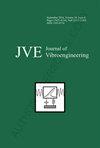基于荷载/卸载响应比理论确定地震作用下跨断裂带隧道稳定性
IF 0.9
Q4 ENGINEERING, MECHANICAL
引用次数: 0
摘要
地震时,地质断层会破坏隧道的稳定性。本研究建立了基于荷载/卸载响应比(LURR)理论的隧道动力稳定性评价指标。将地震波作为荷载/卸载参数,隧道结构应变响应作为响应参数。研究了该评价指标的基本原理和地震条件下影响断裂带隧道稳定性的因素。与传统的动力失稳判据相比,LURR能准确地测量结构偏离稳态的程度,更好地确定结构的潜在失稳区域。随着输入地震波峰值的增大,较不稳定部分的lurr增大,而稳定部分的lurr保持不变。根据LURR理论,地震时断层对隧道的影响范围大小主要取决于断层的固有性质(即断层的倾角、走向和厚度),而与地震烈度无关。由于LURR理论上可以是无穷大的,因此无法准确确定其动态不稳定阈值。本文章由计算机程序翻译,如有差异,请以英文原文为准。
Determining tunnel stability across fault zones under seismic loading based on load/unload response ratio theory
Geological faults impair tunnel stability during earthquakes. This study establishes a tunnel dynamic stability evaluation index based on load/unload response ratio (LURR) theory. It considers a seismic wave as a load/unload parameter and tunnel structure strain response as a response parameter. The rationale behind this evaluation index and the factors affecting tunnel stability across fault zones under seismic conditions are investigated. Compared to the traditional dynamic instability criterion, the LURR accurately measures the degree of structural deviation from the steady state and better determines the potential destabilization region of the structure. As the peak value of the input seismic wave increases, the LURRs of the more unstable parts increase, while the LURRs of the stable parts remain unchanged. According to LURR theory, the size of the range affected by the fault on the tunnel during an earthquake depends mainly on inherent fault properties (i.e., the dip angle, strike, and thickness), independent of the earthquake intensity. Because the LURR can theoretically be infinite, its dynamic instability threshold cannot be determined accurately.
求助全文
通过发布文献求助,成功后即可免费获取论文全文。
去求助
来源期刊

Journal of Vibroengineering
工程技术-工程:机械
CiteScore
1.70
自引率
0.00%
发文量
97
审稿时长
4.5 months
期刊介绍:
Journal of VIBROENGINEERING (JVE) ISSN 1392-8716 is a prestigious peer reviewed International Journal specializing in theoretical and practical aspects of Vibration Engineering. It is indexed in ESCI and other major databases. Published every 1.5 months (8 times yearly), the journal attracts attention from the International Engineering Community.
 求助内容:
求助内容: 应助结果提醒方式:
应助结果提醒方式:


